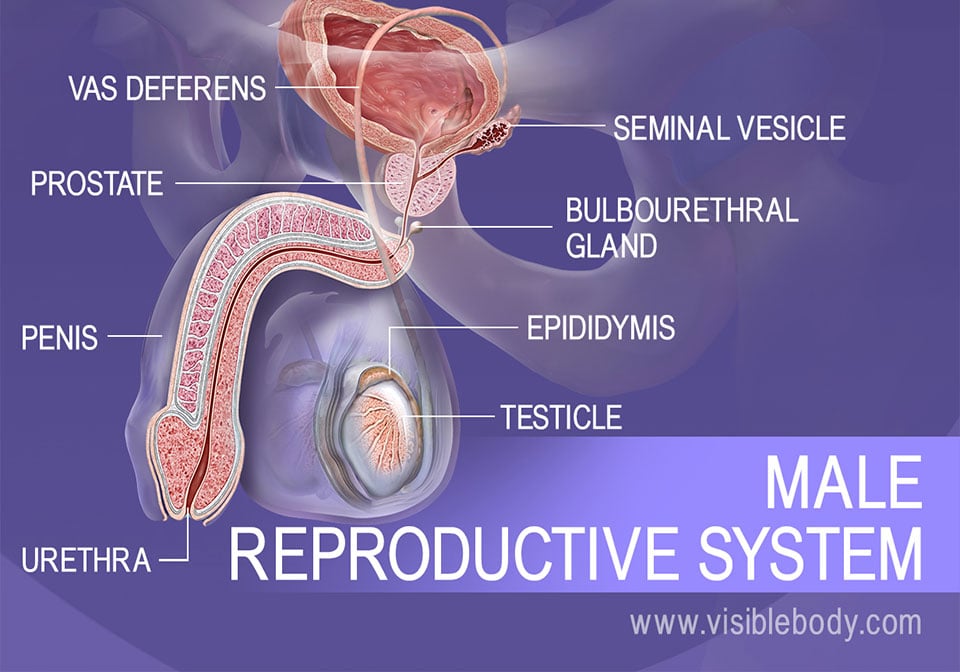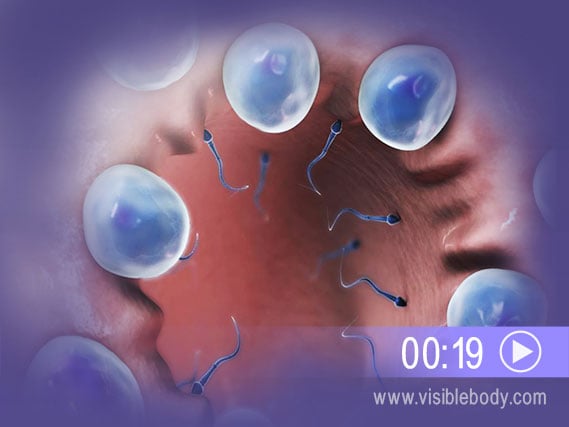
The testes are the primary reproductive organs and generate sperm cells through a process called spermatogenesis. The glands of the male reproductive system produce sperm and seminal fluid. The prostate gland, the seminal vesicles, and the bulbourethral glands contribute seminal fluid to semen, which carries and protects the sperm. During sexual intercourse, semen moves through a series of ducts to deliver the semen directly into the female reproductive system.

The testes (or testicles) are the male gonads and sit below the penis within a sac called the scrotum. They are 4-5 cm long, 2.5 cm in diameter, and covered with two membranous layers, the tunica albuginea and the tunica vaginalis. The testes generate sperm, the male sex cells, as well as testosterone and other sex hormones. The production of sperm is constant and occurs within numerous lobules in each testis. First, structures called seminiferous tubules generate stem cells. These cells, the spermatogonia, divide into spermatocytes, and then divide further to become spermatids. The process is called spermatogenesis. Spermatids move from the testis to the epididymis and mature into sperm.

The epididymis, vas deferens, ejaculatory ducts, and urethra form a four-part transportation system. The epididymis sits directly on top of each testis. Sperm from the testis mature as they move through the coiled duct of the epididymis. During sexual intercourse and ejaculation, they are expelled into the vas deferens. The vas deferens pushes the sperm up over the bladder and down toward the prostate gland. There, the vas deferens joins the ends of the seminal vesicles (accessory reproductive glands) to form the ejaculatory ducts. The ejaculatory ducts receive seminal fluid from the vesicles, pass through the prostate, and move semen into the urethra. The male urethra extends from the bladder, through the prostate, to the external orifice at the end of the penis. It receives additional seminal fluids from the prostate before it expels semen out of the body.

Sperm cells depend on seminal fluid to keep them moving and alive. This fluid is produced during ejaculation by accessory glands: the seminal vesicles, the prostate, and the bulbourethral glands. The seminal vesicles, two saclike structures, sit close behind the bladder and extend toward the bladder. There they each join one of the vas deferens to form the ejaculatory ducts. The vesicles secrete a whitish-brown fluid containing sugars, prostaglandins, and other substances that makes up two-thirds of the semen volume. The prostate, located under the bladder and above the start of the penis, contains the ejaculatory ducts and the prostatic urethra. As semen enters the urethra, the prostate secretes enzymes that help activate the sperm. The bulbourethral glands (or Cowper’s glands) are pea-sized, with single ducts that connect to the urethra where it emerges from the prostate. These glands add mucus that helps with sperm motility.

The penis is part of the male external genitalia, suspended from the body at the front and sides of the pubic arch. Internally, the penis consists of three connected columns of tissue. The paired corpora cavernosa extend together from the root of the penis through the body. The corpus spongiosum runs along the underside of the cavernosa. It contains the spongy urethra and expands past the body of the penis to form the glans penis (the tip). The tissue of the corpora cavernosa and the corpus spongiosum is spongelike in structure. During arousal and intercourse, the spaces in the tissue fill with blood. The penis stiffens. Now it can penetrate the vagina to deliver semen directly into the female reproductive system.
Information on prostate cancer screening from the CDC.
Male reproductive system terms from the Des Moines University Online Medical Terminology Course.
Visible Body Web Suite provides in-depth coverage of each body system in a guided, visually stunning presentation.
When you select "Subscribe" you will start receiving our email newsletter. Use the links at the bottom of any email to manage the type of emails you receive or to unsubscribe. See our privacy policy for additional details.